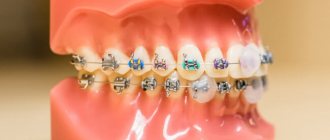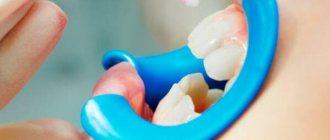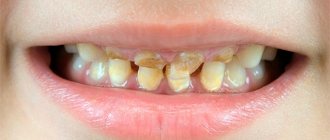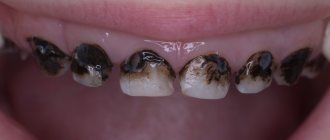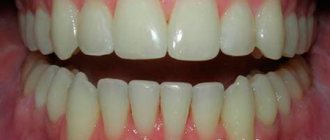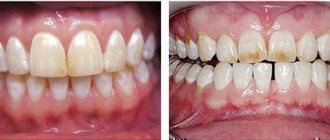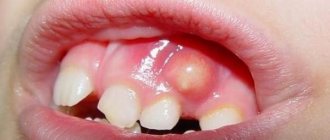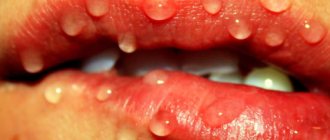Anyone can experience tooth trauma (i.e. dental trauma), but it is more common in children. First of all, during sports, active recreation (hoverboards, skateboards, rollers and other means of transportation), falls and impacts occur. As a result: over the past five years, the number of dental injuries has doubled.
Dental injuries are a serious problem for a child: an adult can replace a knocked-out tooth with an implant with a crown, but such operations are contraindicated for children. So what now - go without a tooth until adulthood? This is unaesthetic and harms the bite and, as a result, articulation.
Meanwhile, a chipped or knocked out child’s tooth can be restored (in adults there is almost no chance of healing). How? Let's talk about this.
Bruised tooth
The child hit himself, but the tooth’s appearance remained almost unchanged - this misleads parents, and they do not turn to a specialist. Very in vain! Bruises can lead to complications.
What are the symptoms? The tooth hurts and sometimes becomes loose. If the neurovascular bundle is damaged, the enamel may turn pink or darken (this happens on the second to tenth day after the injury). A bruise is also indicated by redness, swelling or hematoma on the gum.
What to do? Go to the dentist (even if the child is afraid, there are ways to rid him of this fear)! The doctor will order an x-ray examination to make sure that there are no complications, in particular, a tooth root fracture. Fortunately, most of the time, this type of injury requires only observation. It is better not to load the injured tooth for a couple of days and not to eat anything hard.
What to do if a tooth is knocked out?
What to do if one or several teeth teleported from your mouth into your hand? Under no circumstances should you throw them in your hearts at the offender, but take into account the advice below.
Task No. 1 now is to create conditions for transporting the “fifth element” that is temporarily absent from your dentition. Suitable for this purpose:
- a container of saline solution for contact lenses, if you have one in the glove compartment of your car;
- a carton of milk purchased at the nearest supermarket;
- a container made by yourself from cellophane, with biological fluid (saliva) or water inside;
- a safe place behind your cheek for emergencies.
Now try to remember where the nearest “reputable” medical institution is located - not a paramedic post with an emergency room, but at least a regional hospital or the department of dentistry of a medical university. Only in a hospital setting will you be able to undergo replantation, the implantation of a “native” tooth into damaged gums.
Tooth luxation
Dislocation can be incomplete when the tooth changes its position relative to its “neighbors”, impacted when the tooth is literally driven into the hole, and complete when it leaves its original place. The expression “knocked out a tooth” is just about the third type of dislocation!
What are the symptoms? The change in the position of the dislocated tooth relative to the others is visible to the naked eye. And yes, it will hurt a lot.
What to do? Immediately (within 1-2 hours, otherwise engraftment will not work!) consult a doctor. If the tooth remains in the socket, the dentist will try to realign the dislocation. If the tooth is completely dislocated, they will try to heal it. Several conditions must be met immediately after injury:
- find the tooth
- rinse under running water (hold it by the crown part, not by the root, and do not rub it under any circumstances)
- insert it into place (if it doesn’t work, put it in a container with saline solution, milk or saliva)
- go to your appointment with the container.
First aid supplies
If a child has a knocked out tooth due to injury, it is important to provide first aid correctly. To begin, ask your child to rinse his mouth with clean boiled water cooled to body temperature. If the child is small and does not yet know how to do this, ask him to take water into his mouth several times and spit it out.
Important: if by the time you discover the injury, only a hole filled with a blood clot remains in place of the tooth, you should under no circumstances rinse your mouth. This clot acts as a “plug”, which prevents bleeding and protects the socket from the penetration of microbes and the ingress of soft plaque and food particles into it.
If a child has bleeding from the gums at the site of a knocked out tooth and/or the gums are severely damaged, the first aid algorithm consists of the following sequence of actions:
- In the first few minutes after the injury, do not try to stop the bleeding - the blood flow washes out bacteria and foreign particles that entered it during the injury from the hole.
- If the bleeding does not stop within 5-10 minutes, roll up a tight swab of sterile gauze, place it on the site of the knocked out tooth and ask the child to clench his jaw to hold the swab in place. When rolling up the tampon, make sure that the edges of the napkin are folded inward and that there are no threads sticking out of the tampon. Keep young children in sight to prevent the tampon from getting stuck in their throat.
- If a child complains of severe pain, he can be given Efferalgan, Panadol, Paracetamol or another drug that he usually takes for a sore throat, ARVI and colds. Never give your child NSAIDs, including aspirin or aspirin-containing medications, without consulting a doctor - they reduce blood clotting and can cause bleeding.
If any signs of a tooth fracture are detected in a child, it is necessary to promptly visit a pediatric dentist.
Is it necessary to save a baby tooth?
Fragments of baby teeth are fixed no worse than parts of permanent teeth. But a knocked out baby tooth will most likely not be healed. However, this does not mean that you should neglect going to the dentist. The doctor will firstly look to see if there is a fragment of the tooth root left (it should be removed). And secondly, it will fill the resulting void with a children's prosthesis.
Particularly serious consequences occur in impacted dislocations of baby teeth: without treatment, the rudiments of permanent teeth may die!
If you break or knock out a tooth, you need to:
1. Record the circumstances and time of injury;
2. Try to find a tooth or its fragment;
3. Rinse the found tooth or part of it under running water (you cannot hold it by the root, only by the crown. You should also not rub or brush the surface of the tooth)
4. Place the tooth or its fragment in saline solution, milk or saliva (but not water!)
5. Try to get to the hospital within 1-2 hours after the injury, along with a container to store the knocked out tooth or its fragment.
We thank our expert for preparing the material:
The less time has passed since the injury, the more favorable the treatment prognosis.
Victoria Slepova Pediatric dentist at Megadenta Clinic
Treatment
The choice of treatment method depends on whether the temporary or permanent tooth is damaged, as well as where exactly in the dentition the void has formed.
So, if a child has knocked out his front permanent teeth, it is important to restore the integrity of the dentition as soon as possible.
This is done using a removable or fixed bridge, which is installed after the gums have completely healed. It is important to understand that the jaw bones are actively growing until the end of puberty, and the position of the teeth in the row may change due to this.
For this reason, even the installation of a prosthesis does not relieve the child of the need to regularly visit a doctor who monitors the process of formation of a permanent bite and, if necessary, replaces the prosthesis with another.
Prosthetics are also recommended for children with knocked out baby teeth.
But it is not carried out in all cases. If the child has already reached the age when the replacement of teeth with permanent ones has begun or is expected soon, prosthetics are considered inappropriate, since the growing molar will take over the functions of the knocked out one and “take part” in the formation of the bite.
If a baby tooth is knocked out long before the expected change of teeth, prosthetics are necessary to prevent complications. It is especially important to seek treatment promptly if you have lost your front teeth. They play an important role in articulatory movements and the formation of sounds, so long-term absence of front teeth may lead to the need for speech therapy treatment, even if artificial crowns are subsequently installed.
Restoring a knocked out tooth
After treating the hole, the doctor will order an x-ray examination. The study will identify the type of injury on which further treatment depends. There are several options:
- The tooth is completely knocked out along with the surrounding tissues. In this case, the dentist will try to place the tooth in the socket, giving it the correct anatomical position. The correct installation is checked by bite or repeated x-rays. If necessary, the edges of the wound socket are sutured. After this procedure, the tooth is still mobile, so it must be firmly fixed with a splint. The orthodontist installs the splint. At this point, the first stage of treatment ends, the patient is sent home, having previously been prescribed antibacterial and painkillers. The next visit to the dental clinic is scheduled in 1-2 days. The doctor checks the condition of the sutures and sockets, and also evaluates tooth mobility. If necessary, the installed tire is corrected. It takes 1-2 months for a knocked out tooth to heal. During this time, you will have to visit the dentist several times for examination and control over the healing process. The effectiveness of treatment is assessed using x-rays. If the tooth has taken root, the splint is removed, and the patient continues to be observed by the orthodontist for 6 months.
- The tooth is partially knocked out, the enamel and dentin are damaged. In this case, the tooth may wobble, but remain in the socket. In this case, the dentist performs anesthesia, examination and prescribes treatment, which consists of installing a filling to protect the pulp with subsequent fixation. An X-ray examination must be performed after 3-6 months to diagnose the condition of the pulp and prescribe further treatment.
And now smile!
However, if you decide to replace a lost tooth with an artificial one in a couple of days in order to meet your anniversary, be prepared for disappointment. After all, this is not always possible. The process can be significantly delayed, and not through the doctor’s fault.
First, let’s talk about how exactly implantation occurs.
Stage 1 – treatment planning. The doctor necessarily conducts diagnostics (identifies caries and other diseases of the oral cavity) and plans implantation based on CT (3D imaging). He also gives directions for blood tests (general and clinical) to make sure that the patient does not have blood diseases or other serious conditions. If they are detected, you will need to go to a specialist to determine whether implantation can be performed or whether it is better to postpone it until a stable remission occurs.
Stage 2 – preparation. If diseases of the teeth and gums are detected, they will first have to be treated, because any inflammation in the oral cavity will lead to the implant being simply rejected by the body. If everything is fine, the doctor will carry out professional cleaning (to rid the teeth of hard plaque, under which bacteria can remain), and that’s all.
Stage 3 – implantation itself – implantation of a titanium root into the jaw. The process itself usually takes less than an hour. A hole is formed specifically according to the size of the future root in the bone tissue of the jaw. The sutures are removed after 7–10 days, and a little later the gum former is installed. A few months later, after the impressions are taken, first temporary and then permanent crowns are placed. But there is also a one-stage implantation, in which a prototype of the future tooth is installed in the patient immediately on the day of implantation. And after a couple of months, the temporary crowns are replaced with permanent ones. Accordingly, in this case you will not have to walk without teeth for a day.
Prosthetics. Dentist - about crowns and their installation Read more
Recommendations after tooth extraction in a child
- Immediately after removal, the doctor places a piece of gauze to stop the bleeding. The gauze needs to be changed every 15-20 minutes until a blood clot appears. A blood clot is very important for the successful healing of the socket.
- As a rule, children do not experience severe bleeding after a baby tooth is removed. This is possible only after the removal of a permanent tooth, since it has a different structure.
Rules after tooth extraction:
- don't eat for the first two hours
- in the first day, do not rinse your mouth or spit, as you can displace a blood clot in the tooth socket, and without it complications are possible
- You cannot eat fermented milk products or hot food until the hole heals.
Under no circumstances should you apply compresses or heat the injured area!
